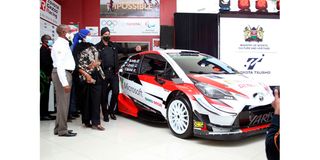Breaking News: At least 10 feared to have drowned in Makueni river
World rally cars are built to FIA specifications

Toyota Kenya Managing Director Arvinder Reel (right) guides Sports Cabinet Secretary Amina Mohammed and WRC Safari Rally Kenya CEO Phineas Kimathi around 2019 Toyota Yaris WRC Replica by Toyota Gazoo Racing team during the unveiling of Toyota Kenya's Sh30 million sponsorship towards the organisation of WRC Safari Rally Kenya at Toyota Kenya Showroom, along Uhuru Highway, Nairobi on May 10, 2021.
What you need to know:
- Opel used former German champion Erwin Webber on the 1982 Jamhuri Rally driving and an Opel Ascona while Nissan used a 200SX Model on the 1988 Firestone Rally with Swedish driver Per Eklund.
- Eklund was navigated by local Rishad Rahim, one of the best technicians in Kenya as Nissan’s link men locally.
A World Rally Car is a racing automobile built to the specifications set by the World Motorsports Body (FIA) which competes in the outright class of the World Rally Championship.
The WRC specifications were introduced by the FIA in 1997 as a replacement for Group A regulations.
***
In relation to motorsport governed by the world motorsports body, Group “R” refers to a set of regulations providing production-derived vehicles for rally competition.
The Group “R” regulations were created in 2008 as a gradual replacement for Group “A” and Group “N” rally cars. To comply with Group “R” regulations, a car must be homologated in Group “A” (or in some cases Group “N”) and receive one or more VR extensions.
Each VR extension is a set of homologated parts and modifications, designed and sold (as a kit or as a complete car) by the manufacturer. As part of its structure, the Group “R” regulations have a provision for GT cars, known as R-GT.
***
According to the FIA, Group “R” consists of six classes, namely R1, R2, R3, R4, R5 and R-GT.
These are rally car models which are frequently mentioned in readiness for the WRC Safari Rally next month. Some of these groups contain their own sub-groups, with cars allocated to each group based on their weight, engine size and powertrain.
The first batch of rules, which were introduced in 2008, featured the R1, R2 and R3 classes. These were restricted to two-wheel drive cars with atmospheric engines up to 2000cc.
Supercharged engines were allowed only in R3T (petrol) and R3D (diesel) sub-classes. Since 2015 the R1, R2 and R3 classes allow supercharged engines with a 1.5 equivalency factor for displacement.
Additional regulations were issued in 2011 which covered the R4 and R-GT classes; the R4 was conceived as an evolutionary step for previously-homologated Group N4 cars, turbocharged, all-wheel drive cars based on production models.
The R4 class is for cars competing under Group “N” regulations for production cars prior to 2013. No new models would be homologated under R4 regulations, with the FIA taking the long-term view that these would be replaced by bespoke kit cars.
The R4 Kit cars have a standard engine, four-wheel drive powertrain and suspension. In January 2017, French racecar manufacturer Oreca was selected as supplier.[6]
***
Did you know that....
Works teams were allowed to test their rally cars for Safari Rally in local events as route openers?
Opel used former German champion Erwin Webber on the 1982 Jamhuri Rally driving and an Opel Ascona while Nissan used a 200SX Model on the 1988 Firestone Rally with Swedish driver Per Eklund.
Eklund was navigated by local Rishad Rahim, one of the best technicians in Kenya as Nissan’s link men locally.




